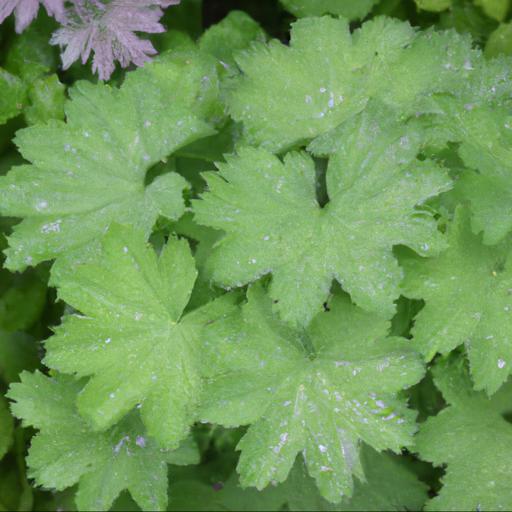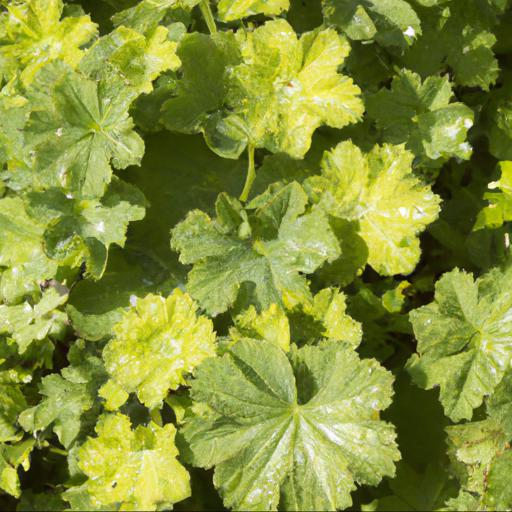Alchemilla mollis, commonly known as Lady’s mantle, is an herbaceous perennial plant that is native to Europe, North Africa, and Asia. It is a member of the Rosaceae family and is known for its attractive foliage, which is composed of deeply-lobed, velvety leaves. The plant is also prized for its delicate yellow-green flowers that bloom in the summer.
Lady’s mantle is a hardy plant and is suitable for growing in a variety of soils and climates. It is an ideal choice for gardeners looking to add texture and color to their landscape.
Lady’s mantle is also known for its medicinal properties and has been used for centuries to treat a range of ailments. It is an easy-to-grow plant that is sure to bring beauty and joy to any garden.
Benefits of growing alchemilla mollis in your garden

Alchemilla mollis, commonly known as Lady’s Mantle, is a wonderful, ornamental herbaceous perennial plant. A member of the Rosaceae family, this is a hardy, shade-loving and relatively low-maintenance addition to any garden.
Gracing the garden with its attractive lacy foliage and pleasantly delicate flowers, this plant can often be seen adorning rock gardens, woodland gardens as well as perennial borders. The foliage of Alchemilla mollis is its most striking feature. Its leaves are divided into lobed, slightly fuzzy leaflets in pairs of three to five.
This can be an attractive addition to the garden, providing texture when the leaves are touched. The plant has green foliage which turns to a reddish hue in the fall and can thrive in partial shade or full sun.
This plant blooms in the summertime, displaying a large number of small, yellow star-shaped flowers boasting subtle veins that resemble little stars. These star-shaped flowers attract a wide variety of beneficial insects, including bumblebees and honeybees, promoting a healthy and balanced ecosystem in the garden. In addition to providing aesthetic appeal, Alchemilla mollis has a number of practical benefits as well.
Its foliage is highly drought-resistant and its deep root system provides great stability for soil erosion control. It is also very low maintenance, with no pruning necessary, and its rhizomatous habit makes it a great choice for ground cover.
All in all, Alchemilla mollis is an excellent addition to any garden – its multifaceted benefits include dazzling foliage and starry blossoms, low maintenance requirements, drought resistance, and soil stabilization. With its delicate beauty, any garden containing this lovely perennial will be sure to make a beautiful and lasting impression.
How to plant and care for alchemilla mollis

Alchemilla mollis, commonly known as Lady’s Mantle, is an easy to care for yet stunningly beautiful perennial. Its deeply serrated, scalloped foliage is equally at home in shady gardens as amongst their sunnier counterparts.
In late spring and summer, the foliage of Alchemilla mollis is positively awash with the delicate chartreuse flowers, reminiscent of lace doilies. Planting Alchemilla mollis is relatively simple and you should start by finding the perfect spot in your garden. It is best to plant Alchemilla in a slightly acidic soil with a PH of between 6 and
Add a generous helping of compost or mulch to provide the necessary nutrients.
Water your newly planted Alchemilla generously and allow the soil to become moist before plugging the drainage hole. Next comes the exciting part – caring for your Alchemilla mollis. Regularly water it during the first two weeks after planting, making sure the soil becomes moist before reducing how often you water.
Fertilize your Alchemilla mollis every 6 to 8 weeks during the growing season to provide adequate nutrition. As with all perennials, it is important to deadhead the flowers during the growing season to prevent the spreading of its seeds. Frost can kill the foliage of Alchemilla mollis during bouts of especially cold weather, so applying a thick layer of mulch to protect the roots of your plants is highly recommended.
Finally, if you want to keep your Alchemilla mollis growing happily for many years to come then remember to divide and replant the clumps every 3 to 4 years. Caring for Alchemilla mollis may seem like a daunting prospect but with a little attention and care, this resilient plant will reward you year after year with its charming appearance.
Whether you choose to let it flourish in a woodland setting or proudly display it in a flower garden, you’ll no doubt be delighted with the results.
Common pests and diseases of alchemilla mollis

When it comes to nurturing a garden, proper identification of common pests and diseases affecting particular plants is key in providing optimal care. Alchemilla mollis is no exception. Known commonly as lady’s mantle, this perennial flowering plant has become a favorite among gardeners because of its elegant, chartreuse-like foliage, which works especially well in cottage and rock gardens.
Like all other plants, however, Alchemilla mollis is vulnerable to pests and diseases that can significantly reduce the health and beauty of your garden if not treated properly. That’s why it’s important to properly identify any diseases or pests that might be affecting your lady’s mantle.
One of the most common diseases affecting Alchemilla mollis is powdery mildew. Characterised by a white, powdery covering on both sides of the leaves, powdery mildew will eventually cause the foliage to yellow and die. If left untreated, the disease will spread to other plants.
The best way to prevent powdery mildew is to reduce the humidity level by improving air circulation and keeping the plant in an area with plenty of sunlight. Another common pest affecting Alchemilla mollis is aphids.
These tiny, soft-bodied insects feed on plants by sucking the sap out of leaves, causing distorted growth and stunted flowering. Aphids are most likely to become a problem when plants are taken indoors during colder temperatures or when there is a decrease in natural predators.
To get rid of aphids, spray the plants with a strong jet of water as soon as you notice an infestation, or use chemical insecticides. By familiarising yourself with the common pests and diseases affecting Alchemilla mollis, you can provide the best care for your lady’s mantle and keep your entire garden looking its best. With the right amount of knowledge and care, you can keep your Alchemilla mollis looking and flourishing for many years to come.
Creative ways to use alchemilla mollis in your garden
If you love the look of an English cottage garden, then Alchemilla mollis, also known as lady’s mantle, is a must for your garden. With its marvelous bright green foliage and delicate, lacy flowers, it’s a hardy and versatile plant that can play an eye-catching role in almost all garden styles. When you think of English cottage gardens, you immediately imagine lots of colorful blooms, but with Alchemilla mollis you can add structure with its glossy star-shaped leaves.
Planting several specimens together gives a carpet of fresh green with repeating patterns. This can look especially striking along a path or around the base of your house.
In a sunnier spot, grouping Alchemilla mollis with other plants, such as Aster divaricatus or Geranium pratense, will set off the magnificent combination of colors those plants have to offer. The strong look of Geranium pratense will blend perfectly with the more delicate nature of the Alchemilla mollis foliage. To really make a statement, try planting it with contrastingly bold colors.
Papaver orientale will bring a brilliant pop of vibrant color, with its bright orange and yellow petals. This is a great way to give your garden an extra shot of interest and vibrant energy.
Alchemilla mollis not only offers eye-catching foliage and delicate flowers, it’s also low maintenance and fairly drought-resistant, making it a great choice for those of us who don’t have much time for a garden. Fill in your beds with this very pretty and elegant flowering perennial and you’ll have a beautiful look all summer long.
Our video recommendation
Final Touch
Alchemilla mollis, commonly known as Lady’s Mantle, is a perennial herb native to Europe, Asia, and North Africa. It is a low-growing plant with soft, velvety leaves and small, yellowish-green flowers.
Lady’s Mantle has long been used in traditional medicine for its anti-inflammatory, astringent, and diuretic properties. It is also used in cosmetics and as a garnish in cooking. Lady’s Mantle is an attractive addition to any garden and is easy to grow and maintain.
FAQ
What are the common names for Alchemilla mollis?
Common names for Alchemilla mollis include Lady’s Mantle, Nine Hooks, and Bear’s Foot.
What are the medicinal uses of Alchemilla mollis?
Alchemilla mollis has been used medicinally for centuries to treat a variety of ailments, including digestive issues, skin problems, and menstrual cramps. It is also believed to have anti-inflammatory, anti-fungal, and anti-bacterial properties.
How can Alchemilla mollis be propagated?
Alchemilla mollis can be propagated by division or by seed.
What is the ideal growing environment for Alchemilla mollis?
The ideal growing environment for Alchemilla mollis is in moist, well-drained soil in partial shade. It prefers a slightly acidic soil with a pH of 6.0-7.0.
What are the common pests and diseases associated with Alchemilla mollis?
Common pests and diseases associated with Alchemilla mollis include powdery mildew, rust, leaf spot, and aphids.
How can Alchemilla mollis be used in landscaping?
Alchemilla mollis can be used in landscaping as a groundcover, as an edging plant, or as a filler in containers and flower beds. It is also a great choice for rock gardens and can be used to create a lush, green backdrop for other plants.

